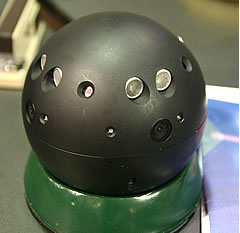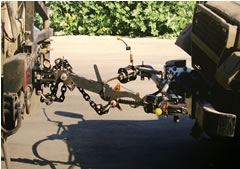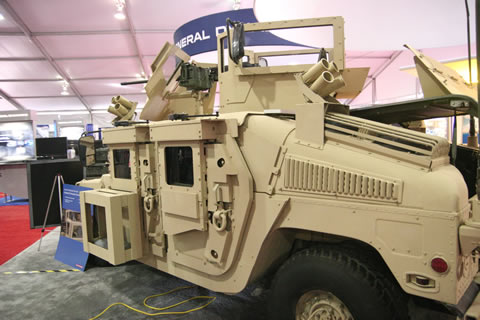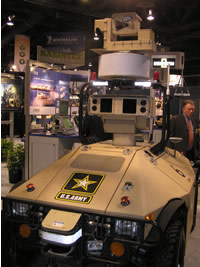Panoramic Vision is becoming a common requirement for modern combat vehicles. A number of systems were displayed at the Modern Day Marine expo, most systems are based on an integration of video images provided from multiple staring cameras (CCDs) into a panoramic view of the vehicle’s surrounding. Panoramic vision systems are considered an essential element for perimeter protection and situational awareness. SA can be further enhanced with the addition of gunshot detection systems and remotely operated weapon stations (RWS) covered in a separate section of this report.
 Boomerang III Acoustic Gunshot detector
Boomerang III Acoustic Gunshot detector
The latest version of the Boomerang acoustic sniper detection system operates on stationary or moving vehicles (up to 60 mph), detecting fire sources by processing the gunshot’s haracteristic acoustic signature, determining the relative shooter’s bearing, elevation and distance. Boomerang III usually processes a gunshot solution within less than a second. To minimize false alarms, the system responds only to gunshot trajectories passing within 30 meters of the sensor mast and shooters firing at maximum effective weapons ranges. The system also filters gunshots fired from the vehicle, signals picked from road bumps, door slams, vehicle backfires, firecrackers, wind effect and radio noise etc.
 MPSVS from EDO
MPSVS from EDO
Multi-user Panoramic Synthetic Vision System (MPSVS) from EDO Corp offers 360 visual situational awareness for crew collaboration and threat engagement. The system uses multiple video cameras installed in a ring mount attached to the base of standard CROWS weapon stations. The system enables the crew to remain ‘buttoned up’ while being fully visually aware and engaged. The system provides 360 stereo 3D images in day and night, under all visibility conditions. A unique capability offered by the system is the use of video change detection for route clearance missions, where previously collected video streams ‘change detection’ algorithms are employed to past (recorded) and live feed, detecting suspicious objects along the route of march. MPSVS can be integrated with counter-sniper systems such as the Boomerang III, to facilitate effective sniper engagement. It also performs passive target designation, which can be use to direct the weapon station or remote weapons. The panoramic coverage enables the crew to constantly survey their perimeter, regardless of the weapon’s line of sight. They can track multiple targets simultaneously in queue for engagement by the weapon station. The system has an integral ‘combat playback’ capability, enabling review of critical events, allowing for the identification of suspicious elements in real-time or during debrief.
 ODR HV from ODF Optronics
ODR HV from ODF Optronics
Another omni-panoramic vision system was displayed by ODF Optronics through their US representative Mistral. The system uses multiple cameras integrated in a bulky sensor pod installed on the vehicle’s roof. The system includes four to six cameras and a single, rotatable high resolution camera, which provides ‘close-up’ viewing of targets of interest. The capture of the omni-directional scene is performed simultaneously from all cameras, staring over a 360 deg. without the need to rotate an imaging device. The system, an evolution of the omni-panoramic mast-mounted camera introduced in 2004, enables multiple users to watch the vehicle’s surroundings simultaneously, each with a specific region of interest or allows for single user surrounding assessment. The rapid ‘stitching’ of pictures, performed in real time and on the move, require significant image processing. Pre-processing is performed on the sensor pole while the remaining is performed on the system’s ‘black box’ or operating computer, which can also be utilized for video motion detection, enabling perimeter protection for ‘silent guard’ mission, offer obstacle avoidance when driving or reversing in narrow urban terrain and offering ‘close-up’ views of specific areas of interest, regardless to where the vehicle or sight is pointing at. This camera is controlled by the operator, and is aimed at locations designated by the controller. Panoramic vision systems are currently considered for installation in various combat vehicles, including the MRAP.
Other topics covered in this review:
- Light but Protected – Near-term HMMWV Replacements
- Bull Offers Maximum protection
- Gearing Up For the Joint Light Tactical vehicle
- JLTV Pathfinder – Combat Tactical Vehicle
- Hybrid Electric JLTV
- Specialized Off-Road Mobility
- Protecting against Blast
- HMMWV Accessories and Upgrades
- Vehicle Recovery in Combat
- Command and Control Systems
- Unmanned Ground Systems & Robotics
- Remote Weapon Systems
- Panoramic Vision Systems
- Advanced Technology for Future Vertical Lift
- Counter IED Technologies
- Weapons & Personal Gear



 VIPeR from Elbit Systems
VIPeR from Elbit Systems For example, the small RMP 50 weighs only 70 lbs (32 kg), but has a maximum payload capacity of 75 lb (34 kg). The RMP 400 has even better ratio – at a curb weight of 240 lbs (109kg) it can carry 400 lbs of payload (181 kg). These robots are designed to operate at a range of 10 – 15 miles (16-24 km) at an off-road speed of up to 18 mph (29 km/h). The RMP robot is powered by 48 NiMh batteries while the larger models use multiple Saphion lithium-ion battery packs. Both versions require battery recharging for 8 – 10 hours. Although these are well adapted to harsh field conditions, the batteries temperature tolerance limit their operational use from -10 to +50 C. This range could be expanded by using different batteries, which could be more suitable for sub-freezing conditions. (Some Saphion cells operate as low as -20C).
For example, the small RMP 50 weighs only 70 lbs (32 kg), but has a maximum payload capacity of 75 lb (34 kg). The RMP 400 has even better ratio – at a curb weight of 240 lbs (109kg) it can carry 400 lbs of payload (181 kg). These robots are designed to operate at a range of 10 – 15 miles (16-24 km) at an off-road speed of up to 18 mph (29 km/h). The RMP robot is powered by 48 NiMh batteries while the larger models use multiple Saphion lithium-ion battery packs. Both versions require battery recharging for 8 – 10 hours. Although these are well adapted to harsh field conditions, the batteries temperature tolerance limit their operational use from -10 to +50 C. This range could be expanded by using different batteries, which could be more suitable for sub-freezing conditions. (Some Saphion cells operate as low as -20C). The live display also provided an insight into the company’s field deployable command and control solutions. A typical application for the COC is the Marine Air Ground Task Force Command and Control (MAGTF-C2) center. Within the MAGTF-C2 environment, information is integrated, aggregated and distributed from disparate C2 and ISR systems to users at all echelons – ranging from the command center to the individual soldier. The MAGTF-C2 concept allows for visualization of a complete air/ground picture, improving Marine planning and execution, while supporting joint forces interoperability. The system utilized General Dynamics C4Systems’ common viewer, facilitating three-dimensional air/ground views and two-dimensional collaborative environment developed for the US Army style ‘Command Post of the Future” (CPOF) system. CPOF applications will be introduced in the standard COC in upcoming months, and are expected to substatianlly improve work efficiency at the COC through collaboration and maintenance of constantly updated COP. Such applications could also be shared, to a limited extent, with command and control of combat elements on the move, considered for deployment in the upcoming months.
The live display also provided an insight into the company’s field deployable command and control solutions. A typical application for the COC is the Marine Air Ground Task Force Command and Control (MAGTF-C2) center. Within the MAGTF-C2 environment, information is integrated, aggregated and distributed from disparate C2 and ISR systems to users at all echelons – ranging from the command center to the individual soldier. The MAGTF-C2 concept allows for visualization of a complete air/ground picture, improving Marine planning and execution, while supporting joint forces interoperability. The system utilized General Dynamics C4Systems’ common viewer, facilitating three-dimensional air/ground views and two-dimensional collaborative environment developed for the US Army style ‘Command Post of the Future” (CPOF) system. CPOF applications will be introduced in the standard COC in upcoming months, and are expected to substatianlly improve work efficiency at the COC through collaboration and maintenance of constantly updated COP. Such applications could also be shared, to a limited extent, with command and control of combat elements on the move, considered for deployment in the upcoming months. 500SE-M GPS Enabled Tactical Camera
500SE-M GPS Enabled Tactical Camera comes in dust, drop and a waterproof impact resistant package with a large 2.5″ screen showing the images taken with superimposed grid position. This information is recorded and stored with every picture taken. After the mission, images are downloaded and processed on a laptop. The report wizard coming with the package, tracks all images plotting the mission’s trail, from GPS track-log ‘breadcrumb’. Each image automatically provides a hyperlink viewed on Google Earth or the military equivalent FalconView. The selected images are imprinted with relevant metadata and embedded into reports.
comes in dust, drop and a waterproof impact resistant package with a large 2.5″ screen showing the images taken with superimposed grid position. This information is recorded and stored with every picture taken. After the mission, images are downloaded and processed on a laptop. The report wizard coming with the package, tracks all images plotting the mission’s trail, from GPS track-log ‘breadcrumb’. Each image automatically provides a hyperlink viewed on Google Earth or the military equivalent FalconView. The selected images are imprinted with relevant metadata and embedded into reports.
 Recovery under fire (RUF) system designed by the Israeli automotive accessories specialist Tal&Hadas enables vehicle recovery during combat operations, specifically in dense urban terrain. The RUF enables tow vehicles to recover RUF equipped disabled vehicles without manual support, thus eliminating the need for warfighters to leave the protected vehicles and expose themselves to hostile fire. The RUF kit can be mounted on a vehicle within fire minutes, without
Recovery under fire (RUF) system designed by the Israeli automotive accessories specialist Tal&Hadas enables vehicle recovery during combat operations, specifically in dense urban terrain. The RUF enables tow vehicles to recover RUF equipped disabled vehicles without manual support, thus eliminating the need for warfighters to leave the protected vehicles and expose themselves to hostile fire. The RUF kit can be mounted on a vehicle within fire minutes, without special tools. During the recovery the towing vehicle can approach the disabled vehicle at wide angles, and maneuver effectively in narrow streets. Tal&Hadas are currently offering the system for the HMMWV, Zeev (Ford 150 based armored vehicle), the David armored Defender, and armored Storm (Jeep based) light vehicles. A heavier version designed for the MRAP will be completed by December 2007.
special tools. During the recovery the towing vehicle can approach the disabled vehicle at wide angles, and maneuver effectively in narrow streets. Tal&Hadas are currently offering the system for the HMMWV, Zeev (Ford 150 based armored vehicle), the David armored Defender, and armored Storm (Jeep based) light vehicles. A heavier version designed for the MRAP will be completed by December 2007.
 Another essential accessory is the electrical door assist mechanism, designed to operate the u-armored door weighing over 400 kg (applied with FRAG 6 kit). This mechanism, introduced by BAE System’s mobility and protection systems (formerly Armor Holdings) can operate the door on level ground or up to 17 deg slope (30%), opening or closing it within five seconds. Another system that became too heavy for manual operation is the gunner protection kit. An electric traverse kit moves the turret at up to 6 rpm, under all inclinations, therefore improving the gunner’s situational awareness and response even under difficult conditions. The traverse mechanism is powered by rechargeable batteries offering independent operation regardless of the vehicle’s condition. BAE Systems also proposes an improved air conditioning and integrated cooling systems,
Another essential accessory is the electrical door assist mechanism, designed to operate the u-armored door weighing over 400 kg (applied with FRAG 6 kit). This mechanism, introduced by BAE System’s mobility and protection systems (formerly Armor Holdings) can operate the door on level ground or up to 17 deg slope (30%), opening or closing it within five seconds. Another system that became too heavy for manual operation is the gunner protection kit. An electric traverse kit moves the turret at up to 6 rpm, under all inclinations, therefore improving the gunner’s situational awareness and response even under difficult conditions. The traverse mechanism is powered by rechargeable batteries offering independent operation regardless of the vehicle’s condition. BAE Systems also proposes an improved air conditioning and integrated cooling systems,  designed to reduce the temperature in the simmering cabin to bearable 82 F (29 C) and further reduce the crew’s temperature to 60-70 F (15-21C), utilizing water circulating cooling vests.
designed to reduce the temperature in the simmering cabin to bearable 82 F (29 C) and further reduce the crew’s temperature to 60-70 F (15-21C), utilizing water circulating cooling vests.
 Several companies presented blast protected seat technologies at Modern Day Marine and AUSA 07. For example, ArmorWorks displayed two types of blast attenuating seats of the ShockRide series. The company offers individual, folding high-back troop seats as well as driver and commander’s seats with rigid base. Both types are fitted with blast attenuating straps and frame. ArmorWorks also designed bench seats offering improved protection as well as a gunner’s post mounted seat which offers four point restraint harness and flip-up mechanism, improving comfort, access and survivability.
Several companies presented blast protected seat technologies at Modern Day Marine and AUSA 07. For example, ArmorWorks displayed two types of blast attenuating seats of the ShockRide series. The company offers individual, folding high-back troop seats as well as driver and commander’s seats with rigid base. Both types are fitted with blast attenuating straps and frame. ArmorWorks also designed bench seats offering improved protection as well as a gunner’s post mounted seat which offers four point restraint harness and flip-up mechanism, improving comfort, access and survivability. BAE Systems also produces different designs for mine blast, driver/passenger and troop seats. These seats can absorb energy pulses exceeding 400 G by employing vertical, fixed load wire benders providing five inches of downward stroke. (9″ or 23 cm in the troop seats). The troop seats use hinged pan for stowage when not in use. The energy absorbing system uses four point restraint, integral headrest and shoulder cushion.
BAE Systems also produces different designs for mine blast, driver/passenger and troop seats. These seats can absorb energy pulses exceeding 400 G by employing vertical, fixed load wire benders providing five inches of downward stroke. (9″ or 23 cm in the troop seats). The troop seats use hinged pan for stowage when not in use. The energy absorbing system uses four point restraint, integral headrest and shoulder cushion. Another type of blast protected seat is produced by Plasan Sasa and installed in the
Another type of blast protected seat is produced by Plasan Sasa and installed in the 
 Another light tactical vehicle is proposed by the armored tactical vehicle (ATV) manufacturer Polaris Defense. The company offers the Ultra Light Tactical Vehicle with a 40 hp engine powered by gas or JP8 fuel. This vehicle configured to carry a crew of four seated side by side, is rated for payload capacity or towing of up to 1,500 lbs. The rear flat bed can be configured to carry specialist equipment such as combat recon, surveillance, sensors, or anti-tank missiles (Javelin), ammunition, supplies and litter racks for casualty evacuation.
Another light tactical vehicle is proposed by the armored tactical vehicle (ATV) manufacturer Polaris Defense. The company offers the Ultra Light Tactical Vehicle with a 40 hp engine powered by gas or JP8 fuel. This vehicle configured to carry a crew of four seated side by side, is rated for payload capacity or towing of up to 1,500 lbs. The rear flat bed can be configured to carry specialist equipment such as combat recon, surveillance, sensors, or anti-tank missiles (Javelin), ammunition, supplies and litter racks for casualty evacuation. Raytheon’s entry into the light strike vehicle field is also based on an off-road racing and extreme rock crawler derivative. But Raytheon decided to take innovation one step further introducing a powerful hybrid electric drive system, with the all-terrain vehicle called Hy-DRA (Hybrid Defense Recon Assault vehicle). The vehicle uses a diesel engine to power a generator, driving four in-hub motors for the four wheel drive. While moving in ‘stealth mode’ HyDRA can achieve speed up to 35 mph. Otherwise, hybrid powered (diesel and electrical) sustained speed top 125 mph. The hybrid electric drive offers good fuel efficiency of about 35 mpg. The vehicle can carry an M2 (0.50 Cal) or Mk-19 or minigun on a turret mount and an M240/249 on a swing arm. The vehicle has a curb weight of 2,400 lbs. carrying a crew of three, and a complement of weapons and supplies, HyDRA is internally transported in a CV-22 Osprey, CH/MH-53, CH/MH-47 and C-130. It is capable of towing 1.5 tons or carrying heavy loads of up to half a ton. Besides its role as primary propulsion for the vehicle, the four 40hp motors can also perform as generators, providing 30 kW of power for external use.
Raytheon’s entry into the light strike vehicle field is also based on an off-road racing and extreme rock crawler derivative. But Raytheon decided to take innovation one step further introducing a powerful hybrid electric drive system, with the all-terrain vehicle called Hy-DRA (Hybrid Defense Recon Assault vehicle). The vehicle uses a diesel engine to power a generator, driving four in-hub motors for the four wheel drive. While moving in ‘stealth mode’ HyDRA can achieve speed up to 35 mph. Otherwise, hybrid powered (diesel and electrical) sustained speed top 125 mph. The hybrid electric drive offers good fuel efficiency of about 35 mpg. The vehicle can carry an M2 (0.50 Cal) or Mk-19 or minigun on a turret mount and an M240/249 on a swing arm. The vehicle has a curb weight of 2,400 lbs. carrying a crew of three, and a complement of weapons and supplies, HyDRA is internally transported in a CV-22 Osprey, CH/MH-53, CH/MH-47 and C-130. It is capable of towing 1.5 tons or carrying heavy loads of up to half a ton. Besides its role as primary propulsion for the vehicle, the four 40hp motors can also perform as generators, providing 30 kW of power for external use.
 GDLS and AM General invested over $10 million for risk reduction development and maturation of this vehicle and its innovative In-Hub Hybrid Electric Drive system. AGMV has unique protection attributes, combining a hexagon shaped armored capsule for mine protection while optimizing also for side blast deflection and small-arms protection. At a gross vehicle weight of 14,000 – 16,000 lbs with integral A kit armor, protecting against small arms, mines, IEDs and blast, the new vehicle can carry payloads of up to 5,000 lbs and be air transportable in C-130, CH-53 and CH-47.
GDLS and AM General invested over $10 million for risk reduction development and maturation of this vehicle and its innovative In-Hub Hybrid Electric Drive system. AGMV has unique protection attributes, combining a hexagon shaped armored capsule for mine protection while optimizing also for side blast deflection and small-arms protection. At a gross vehicle weight of 14,000 – 16,000 lbs with integral A kit armor, protecting against small arms, mines, IEDs and blast, the new vehicle can carry payloads of up to 5,000 lbs and be air transportable in C-130, CH-53 and CH-47.
 Light Utility Hybrid (LUV) from MillenWorks
Light Utility Hybrid (LUV) from MillenWorks



 UT-25-30mm Unmanned Turret Weapon Station
UT-25-30mm Unmanned Turret Weapon Station ILWS (ORCWS 7.62)
ILWS (ORCWS 7.62) Small Caliber UltraLight (SCUL)
Small Caliber UltraLight (SCUL)

 situational awareness and mission capability. The increased visibility and lightweight design minimizes eye and neck strain, common problems for pilots managing the demands of longer missions and increasingly complex rules of engagement. Additionally, the decreased size and weight of the display allows the pilot complete freedom of movement within the cockpit.
situational awareness and mission capability. The increased visibility and lightweight design minimizes eye and neck strain, common problems for pilots managing the demands of longer missions and increasingly complex rules of engagement. Additionally, the decreased size and weight of the display allows the pilot complete freedom of movement within the cockpit.
 A160T
A160T 18 consecutive hours with a 300-pound payload. At AUSA Boeing displayed a model of an armed version of the A160T, loaded with an EO payload and eight Hellfire type missiles. The vehicle has a length of 35 feet and a 36-foot rotor diameter.
18 consecutive hours with a 300-pound payload. At AUSA Boeing displayed a model of an armed version of the A160T, loaded with an EO payload and eight Hellfire type missiles. The vehicle has a length of 35 feet and a 36-foot rotor diameter. nd improved braking. An EOD MAARS will be equipped with a new manipulator arm having a nominal 100 lb lift capability. The arm can quickly replace the turret mounted M240B weapon, literally transforming from a remote weapons platform to an Improvised Explosive Device (IED).
nd improved braking. An EOD MAARS will be equipped with a new manipulator arm having a nominal 100 lb lift capability. The arm can quickly replace the turret mounted M240B weapon, literally transforming from a remote weapons platform to an Improvised Explosive Device (IED). General Atomics and Jadoo Power have teamed to develop power systems, replacing the heavy batteries carried by individual soldiers. The new power system is based on a fuel cell and fuel interface technology system developed by Jadoo Power, based on General Atomics’ patented ammonia borane fuel technology. In this process, the hydrogen fuel is stored in solid chemical hydride (ammonia borane). This material is decompressed to release the fuel. This material contains hydrogen twice the hydrogen volume, compared with cryogenic stored liquid hydrogen or nearly four times as compressed gaseous hydrogen (10,000 psi).
General Atomics and Jadoo Power have teamed to develop power systems, replacing the heavy batteries carried by individual soldiers. The new power system is based on a fuel cell and fuel interface technology system developed by Jadoo Power, based on General Atomics’ patented ammonia borane fuel technology. In this process, the hydrogen fuel is stored in solid chemical hydride (ammonia borane). This material is decompressed to release the fuel. This material contains hydrogen twice the hydrogen volume, compared with cryogenic stored liquid hydrogen or nearly four times as compressed gaseous hydrogen (10,000 psi). Ultralife introduced the UBBL10, a new product in its “SmartCircuit” (SMBus compliant) family of batteries. This model is compatible with the popular BB-2590 format offering full compliance with the open source SMBus communications protocol. Ultralife’s SmartCircuit batteries/charger/appliance communications improves battery efficiency over its life cycle. Ultralife offers the 2590 type package in a higher capacity version, delivering 18.4Ah in 12V mode. The battery designated UBBL09 is suitable for applications that previously used nickel-metal hydride type cells.
Ultralife introduced the UBBL10, a new product in its “SmartCircuit” (SMBus compliant) family of batteries. This model is compatible with the popular BB-2590 format offering full compliance with the open source SMBus communications protocol. Ultralife’s SmartCircuit batteries/charger/appliance communications improves battery efficiency over its life cycle. Ultralife offers the 2590 type package in a higher capacity version, delivering 18.4Ah in 12V mode. The battery designated UBBL09 is suitable for applications that previously used nickel-metal hydride type cells.












